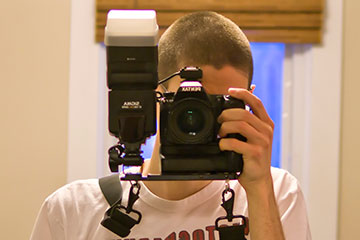Strobe photography is the use of a lighting device attached or installed in your camera that provides a burst of light allowing you the ability to properly expose an image in any amount of available light. There are considerable benefits to having additional light at your control, especially in the ever changing setting of convention photography. Most camera bodies have a built-in pop-up flash installed that is generally pretty serviceable, but they lack in power and tend to produce harsh highlights on subjects. Optionally, you can buy a cheap universal clip-on diffuser that will help soften that light to make it more usable.

What most people do is buy a hot-shoe add-on flash (hot-shoe is the connection on the top of the camera body). These flash devices come in a multitude of different flavors and price points between $75 and $600. The “head” of more expensive add-on flash devices can pivot vertically and/or horizontally allowing you to bounce light off of objects such as the ceiling. Flash diffusers are also available in universal and custom options. Everything from custom white plastic clip-on to large bulb and small soft boxes are available as add-ons.
To start off, find a mid-range flash that can pivot the flash head in both directions. It’s probably best to go with the same brand as your camera body, but if you want to save some money, Sigma units are generally pretty decent in both power and features. Look at the Flash’s “guide number” to determine how powerful it is in general compared to others in the same price range if having the most power is important to you. More power will mean that the flash can fully light scenes that use more wide angle and telephoto lenses compared to ones with a lower guide number. Just keep in mind that if you plan on using a diffuser, your range will be decreased, but your ability to use wider angle lenses will be increased (depending on the type of diffuser used).
The usual goal with strobe lighting is to use that additional light to uniformly expose the scene. That means the strobe flash will only partly be responsible for lighting your subject. I’ll be discussing the removal of harsh light in the next section. Often a strobe flash is vital for doing that. As such, I will be describing how the camera works with add-on flash.
- Overview
- Who is this for?
- What is convention photography?
- My experience and experiences
- Why be a part of this?
- Practice, practice, practice!
- Networking
- Fun
- Photography terms primer.
- Equipment
- It is important or not depending on your ideals
- A basic setup.
- Decide how you want to make it work.
- Framing and composition
- Full body shots.
- Portrait style.
- Skewed angles.
- Face in detail.
- Plane of focus.
- Rule of thirds and golden ratio
- Available light photography.
- Strobe photography.
- Removing harsh light.
- Flash brackets.
- Bokeh and blur maximization.
- Histogram reading and image review.
- Post processing.
- Various schools of thought.
- Available software on your OS of choice.
- Ideas on how to improve your processing.
- Business cards.
- Social networking.
- Website
- The process from start to finish.
- My equipment.
- Ask the person first.
- Interrupting people.
- Constrained areas.
- Physical activity.
- Summary
